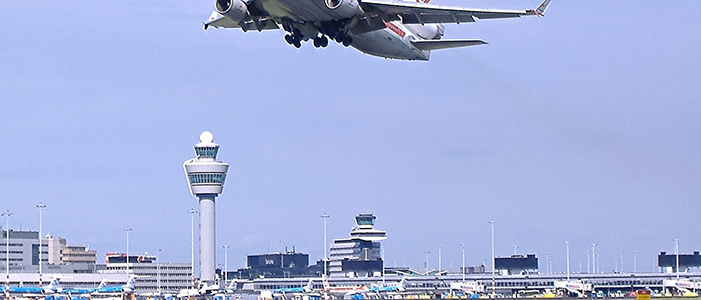Schiphol Airport and the Port of Rotterdam are the Dutch ‘mainports’. In the Netherlands you don’t question the national mainport policy easily. That evokes emotions, rooted in a rich history, with little room for nuance. Nevertheless, the Council for the Environment and Infrastructure (Raad voor de Leefomgeving en Infrastructuur, Rli) in 2016 thought it necessary to do so. An interview with chairman Jan Jaap de Graeff about the advice ‘Beyond Mainports: a new perspective‘ and the discussion that this report started.
The article below is a translation of a publication in Tijdschrit Milieu (‘Journal Environment’) of March 2018. It links in with our recent attention for economic aspects of big airports.
Three years ago, the question was asked for the first time in the council: how are the mainports doing? Initially the focus was on the position of the mainports in relation to other main-ports elsewhere in the world. What advice could the Council give when it comes to better positioning of our mainports? Gradually this question has shifted somewhat and the council started looking at the economic importance of the mainports. Jan Jaap de Graeff: “We came to the conclusion that while the economic interest is and remains very large, this interest decreases in relation to other regions and other sectors. Other regions and industries, such as the digital industry, have grown much faster. The emphasis of the advice was then shifted to the question: what should the government do to improve the business climate in the Netherlands and what role do the mainports of Schiphol and the port of Rotterdam play in this?
Significance for location policy
And it wasn’t just the insight of the relatively declining economic significance of the mainports. In the mainport policy that started in the late 1980s, there was a strong emphasis on volume growth. The council noted that the economic significance of this had also become more limited in various respects. “What matters is the kind of growth you emphasize,” says De Graeff. “The economic importance for the Netherlands of passengers using Schiphol as a transfer location is more limited than that of business travellers and tourists visiting and staying in the Netherlands. As a second main point of our advice we said: ‘Think again about the kind of growth that you want to accommodate as a public interest. And also think about a lower limit: which minimum volume is at least necessary for Schiphol to remain attractive as an airport. “Unrestricted growth also entails various environmental concerns, such as noise pollution and CO2.”
The board makes a difference between the interests of the Netherlands, Inc. and that of Schiphol. What is important for Schiphol may be different for the Netherlands, Inc. “For Schiphol, Inc., Schiphol is of particular importance when it comes to the business climate. It is absolutely true that the tourism and business sector benefit from the presence of Schiphol. It is of great importance that Schiphol can continue to fulfill this function.
The government also has the question of what kind of growth you want to invest. The national government wants to invest primarily in the growth that is important for the business climate in the Netherlands. This does not necessarily mean facilitating all forms of growth, which is primarily a Schiphol interest. It is also important that this growth takes place within acceptable environmental limits. Because otherwise you just won’t get any further.”
Control of volume growth
The Rli chairman makes the comparison with the natural gas problem (earthquakes in the northern province Groningen due to gas production, WL). “If you, as a government, are too lenient for too long, then there may come a time when people no longer accept it all. At that time, there is often no stopping. You then face a certain risk that also the great significance of Schiphol and the interests that exist for the Netherlands,Inc. will be affected. Controlling volume growth due to noise and CO2 problems is therefore important for all parties involved. Stretching boundaries too far can be the opposite. Look what happened in Groningen, you see how quickly the political climate with regard to the extraction of natural gas has been reversed. Then suddenly much less is possible. As far as the mainports are concerned, we have to be ahead of them”. The spatial embedding of Schiphol in its environment has only partially succeeded. Although much has been done to investigate where additional flight movements are possible, it still squeezes. At one point, the alternative development of Lelystad Airport was sought. De Graeff: “The cabinet has been in trouble with Lelystad, not least because the last Environmental Report turned out to be incorrect. The question now is to what extent, and when the plans regarding Lelystad can continue, while Schiphol is already approaching the limits of what is possible.
Money and attention
The Council argues for a broadening of the discussion about the economic significance of the mainports in relation to other regions such as ‘Brainport Eindhoven’ respectively other sectors. That does not take the great importance of both mainports away, but from the perspective of the business climate of the Netherlands you have to look wider and further. To what extent is the vision and analysis of the Council shared by parties that are strongly connected to the mainport policy? De Graeff: “Unsurprisingly, our report in the Eindhoven region was greeted with cheers, while the reverse happened at Schiphol and in Rotterdam. The government can only spend an X amount of euros. Competition might arise between what the government can spend on both mainports and can spend elsewhere. At Schiphol and the port of Rotterdam there is concern that in the long run the government will pay less attention to the mainports and will invest less in, for example, infrastructure.”
“I also noticed that when you question the meaning of Schiphol Airport and the port of Rotterdam, you hit a kind of ‘primal feeling’: what is good for the port of Rotterdam and Schiphol is good for the Netherlands. There is a strong identification with prosperity in the Netherlands. If you place any question marks there, people will think that you put both ports at the dirt. To the left side of the social spectrum you see – also wrongly – the opposite reaction: ‘Look, the Council also says there must be no more investments in both mainports’. There is little room for nuance. We have realized that, but apparently it is still insufficient.
Take, for example, the title of the report ‘Beyond Mainports’. It should have been: ‘Beyond the mainports’. This is partly a wrong perception, as if we say that it’s over with the mainports, but that wasn’t what the Council meant to say. With the benefit of hindsight I certainly had chosen another title. Although this one helped to start the discussion.”
Wouldn’t it be in the interest of Schiphol and the port of Rotterdam to consult him? “They do that. For example, the port of Rotterdam years ago started to open up a new horizon. The work of men is susceptible to change. An important difference with the port of Rotterdam is that the problems are more manifest there, while Schiphol still has a stormy growth. In addition, at Schiphol there is – literally – less room for maneuver to solve the problems. It is cold comfort that the airports elsewhere in the world have more or less comparable problems.”
Business location factors
De Graeff finally points to the importance of soft location factors. According to the Council, these factors are underexposed in the discussion about strengthening the business climate. “The government should look into this more. In particular to location factors as culture, nature and landscape. My impression is that, especially in the last ten years, these are very important factors for people who want to establish themselves in the Netherlands and of course also for tourism. In the Netherlands we have had the chance to keep entire areas open in a densely populated. Once you’re out of Amsterdam, you’re in the most beautiful places within an hour. There is no country in the world with so many varieties and that is all accessible from those urban regions. That is different in New York, London and Paris.”
Courtesy of Tijdschrift Milieu (translation Wouter Looman)






